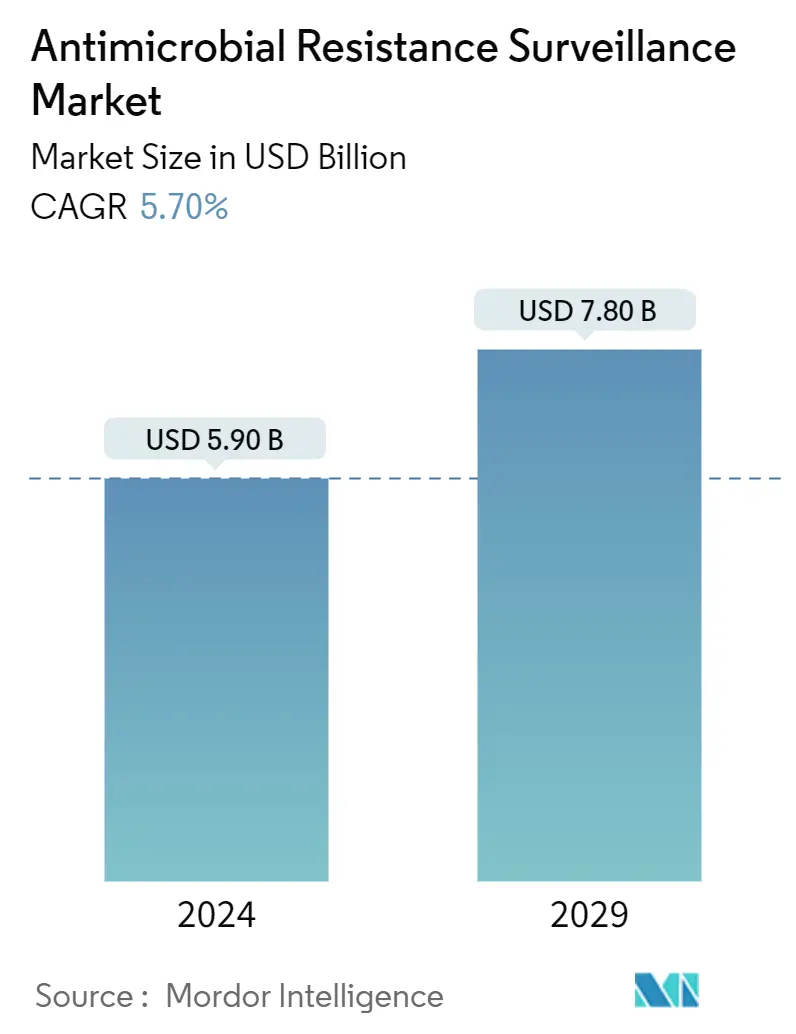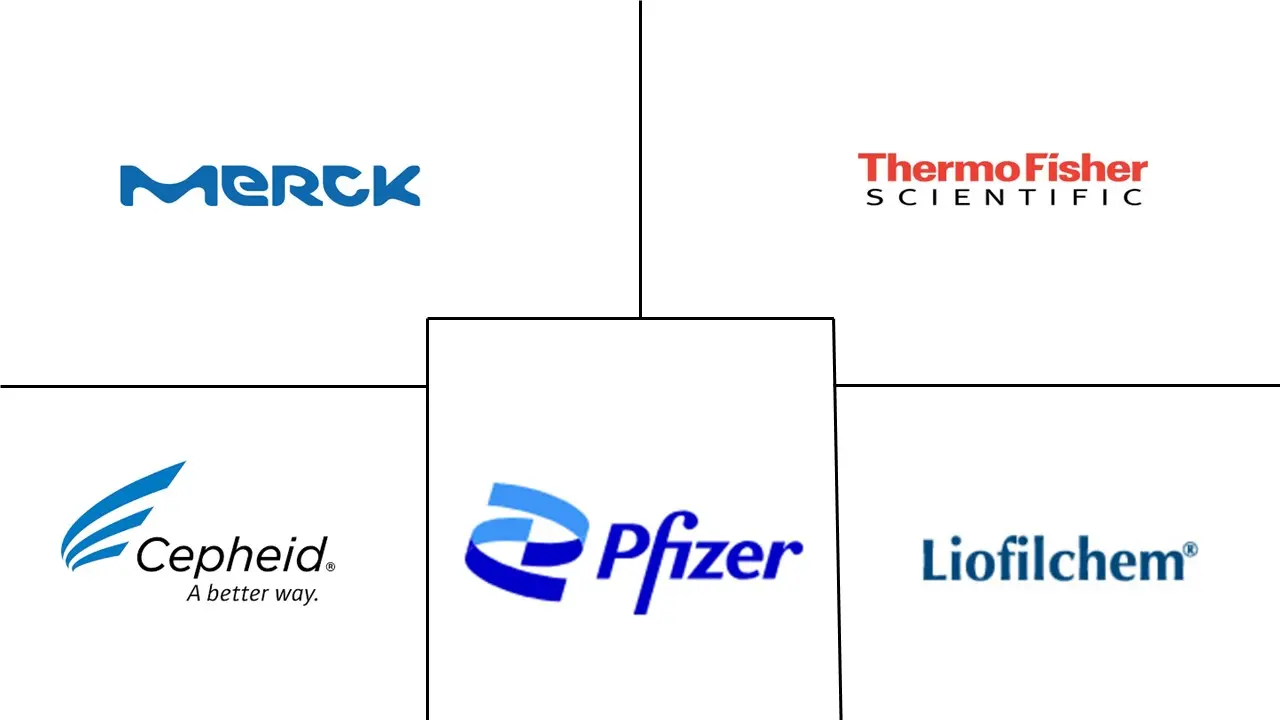Market Size of Antimicrobial Resistance Surveillance Industry

| Study Period | 2019-2029 |
| Market Size (2024) | USD 5.90 Billion |
| Market Size (2029) | USD 7.80 Billion |
| CAGR (2024 - 2029) | 5.70 % |
| Fastest Growing Market | Asia Pacific |
| Largest Market | North America |
| Market Concentration | Medium |
Major Players
*Disclaimer: Major Players sorted in no particular order |
Antimicrobial Resistance Surveillance Market Analysis
The Antimicrobial Resistance Surveillance Market size is estimated at USD 5.90 billion in 2024, and is expected to reach USD 7.80 billion by 2029, growing at a CAGR of 5.70% during the forecast period (2024-2029).
The emergence of the COVID-19 pandemic had a mixed impact on the antimicrobial resistance surveillance market. The market was impacted during the pandemic owing to the overload of healthcare services, and most diagnostic labs diverted their complete focus to COVID-19 tests, which led to a reduction in the identification and tracking of antimicrobial-resistant bacteria during the pandemic period. According to the World Health Organization (WHO) Global Antimicrobial Resistance and Use Surveillance System (GLASS) Report 2022, COVID-19 significantly impacted antimicrobial surveillance during the first wave of the pandemic. Most countries that contribute antimicrobial resistance surveillance data to the WHO GLASS database cannot provide data during the peak stage of the pandemic. However, according to the same report, many countries have increased their laboratory capabilities and other antimicrobial surveillance system-strengthening efforts post-pandemic. This is expected to accelerate the antimicrobial resistance surveillance market during the forecasted period.
The major factors driving the market are the rising prevalence of infections caused by drug-resistant microbes, rising initiatives by governments to tackle infectious diseases, and emerging multi-drug resistance due to drug abuse. The WHO has declared antimicrobial resistance as a major threat to humanity. According to The European Centre for Disease Prevention and Control (ECDC) 2023 Report, each year, more than 670,000 infections occur in the European Union region due to bacteria resistant to antibiotics. This infection outbreak is majorly due to overuse or misuse of antibiotics. Furthermore, according to the Organization for Economic Cooperation and Development (OECD) 2023 data, the European Union spends 1.1 billion every year to combat antimicrobial Resistance infections (AMR). To reduce misuse and overuse of antimicrobial agents’ proper surveillance of AMR is needed to collect up-to-date information which helps doctors and patients make informed decisions about AMR treatment options; hence, WHO introduced the Global Antimicrobial Resistance and Use Surveillance System (GLASS), which collects antimicrobial resistance microbes’ data from 190 countries across the world every year. Thus, increasing the prevalence rate of antimicrobial resistance infections and accelerated surveillance to control AMR efforts of WHO to combat antimicrobial resistance microbes are expected to drive the antimicrobial resistance surveillance market.
Moreover, rising initiatives by governments to tackle infectious diseases will likely accelerate the market. Different nations across the world have taken initiatives to control the complex problem of antimicrobial resistance (AMR) by enhancing surveillance measures, promoting research and development activities, and collaborative actions to control antimicrobial resistance agents. For instance, the United States has launched the National Action Plan for Combating Antibiotic-Resistant Bacteria (CARB), 2020-2025. This initiative by the government will focus on five objectives: increasing stringing surveillance is one major objective to control the prevalence rate and mortality rate due to antimicrobial resistance infections. In addition, Asian countries like India also launched a Nation Action Plan (NAP) for antimicrobial resistance, which also focuses on the surveillance of antibiotic-resistant microbes. Hence, collective efforts of governments are expected to accelerate the antimicrobial resistance surveillance market.
Furthermore, the emergence of multi-drug resistance due to drug abuse is leading to an emergency crisis. There are many infecting agents (e.g., bacteria, fungi, viruses, and parasites) that can cause Multi-Drug Resistance such microbes are known as ‘superbugs.’ The major cause of MDR is overuse of OTC antibiotics and inadequate sanitary conditions maintenance. For Instance, According to Springer Nature Report 2023, the prevalence rate of MDR is 450,000 in 2021, which increased from 430,000 cases from the previous year. Hence, the emergence of multi-drug resistance is expected to lead to high surveillance efforts, which will likely drive the Antimicrobial Resistance Surveillance Market.
However, the higher cost of antimicrobial resistance surveillance systems and kits will likely restrain the growth of the antimicrobial resistance surveillance market.
Antimicrobial Resistance Surveillance Industry Segmentation
As per the scope of the report, antimicrobial resistance surveillance refers to the collection and analysis of antimicrobial resistance microbes’ data for the detection and monitoring of different infections caused by these agents.
The antimicrobial resistance surveillance market is segmented by solution (kits, systems, surveillance software, and surveillance services), application (clinical diagnostics, public health surveillance, and other applications), end user (hospitals and clinics, diagnostic centers, and other end-users), and geography (North America, Europe, Asia-Pacific, the Middle East and Africa, and South America).
The report offers the value (in USD) for the above segments.
The market report also covers the estimated market sizes and trends for 17 different countries across major regions globally.
| By Solution | |
| Kits | |
| System | |
| Surveillance Software | |
| Surveillance Service |
| By Application | |
| Clinical Diagnostics | |
| Public Health Surveillance | |
| Other Applications |
| By End-User | |
| Hospitals and Clinics | |
| Diagnostic Centers | |
| Other End-Users |
| Geography | ||||||||
| ||||||||
| ||||||||
| ||||||||
| ||||||||
|
Antimicrobial Resistance Surveillance Market Size Summary
The antimicrobial resistance surveillance market is poised for significant growth over the forecast period, driven by the increasing prevalence of infections caused by drug-resistant microbes and the urgent need for effective surveillance systems. The COVID-19 pandemic initially hindered the market's progress by diverting healthcare resources towards pandemic response efforts, but post-pandemic, there has been a resurgence in laboratory capabilities and surveillance initiatives. The World Health Organization's Global Antimicrobial Resistance and Use Surveillance System (GLASS) plays a crucial role in this landscape, collecting data from numerous countries to inform strategies against antimicrobial resistance (AMR). Government initiatives worldwide, such as the United States' National Action Plan and similar efforts in Asian countries, are further bolstering the market by enhancing surveillance measures and promoting research and development to combat AMR.
North America is expected to lead the market due to high awareness and significant government investments aimed at combating antibiotic resistance. The presence of key market players in the region, coupled with initiatives like the CDC’s Antimicrobial Resistance Laboratory Network, underscores the region's commitment to addressing this critical issue. The market is moderately consolidated, with major players engaging in strategic alliances and geographic expansion to strengthen their market positions. Despite the challenges posed by the high costs of surveillance systems, the market is anticipated to grow, supported by increased investments in clinical diagnostics and government efforts to improve healthcare infrastructure.
Antimicrobial Resistance Surveillance Market Size - Table of Contents
-
1. MARKET DYNAMICS
-
1.1 Market Overview
-
1.2 Market Drivers
-
1.2.1 Rising Prevalence of Infections Caused by Drug-resistance Microbes
-
1.2.2 Rising Initiatives by Governments to Tackle Infectious Diseases
-
1.2.3 Emerging of Multi-Drug Resistance Due to Drug Abuse
-
-
1.3 Market Restraints
-
1.3.1 Higher Costs of Antimicrobial Resistance Surveillance systems and kits
-
-
1.4 Porter's Five Forces Analysis
-
1.4.1 Bargaining Power of Suppliers
-
1.4.2 Bargaining Power of Buyers/Consumers
-
1.4.3 Threat of New Entrants
-
1.4.4 Threat of Substitute Products
-
1.4.5 Intensity of Competitive Rivalry
-
-
-
2. MARKET SEGMENTATION (Market Size by Value-USD)
-
2.1 By Solution
-
2.1.1 Kits
-
2.1.2 System
-
2.1.3 Surveillance Software
-
2.1.4 Surveillance Service
-
-
2.2 By Application
-
2.2.1 Clinical Diagnostics
-
2.2.2 Public Health Surveillance
-
2.2.3 Other Applications
-
-
2.3 By End-User
-
2.3.1 Hospitals and Clinics
-
2.3.2 Diagnostic Centers
-
2.3.3 Other End-Users
-
-
2.4 Geography
-
2.4.1 North America
-
2.4.1.1 United States
-
2.4.1.2 Canada
-
2.4.1.3 Mexico
-
-
2.4.2 Europe
-
2.4.2.1 Germany
-
2.4.2.2 United Kingdom
-
2.4.2.3 France
-
2.4.2.4 Italy
-
2.4.2.5 Spain
-
2.4.2.6 Rest of Europe
-
-
2.4.3 Asia-Pacific
-
2.4.3.1 China
-
2.4.3.2 Japan
-
2.4.3.3 India
-
2.4.3.4 Australia
-
2.4.3.5 South Korea
-
2.4.3.6 Rest of Asia-Pacific
-
-
2.4.4 Middle East and Africa
-
2.4.4.1 GCC
-
2.4.4.2 South Africa
-
2.4.4.3 Rest of Middle East and Africa
-
-
2.4.5 South America
-
2.4.5.1 Brazil
-
2.4.5.2 Argentina
-
2.4.5.3 Rest of South America
-
-
-
Antimicrobial Resistance Surveillance Market Size FAQs
How big is the Antimicrobial Resistance Surveillance Market?
The Antimicrobial Resistance Surveillance Market size is expected to reach USD 5.90 billion in 2024 and grow at a CAGR of 5.70% to reach USD 7.80 billion by 2029.
What is the current Antimicrobial Resistance Surveillance Market size?
In 2024, the Antimicrobial Resistance Surveillance Market size is expected to reach USD 5.90 billion.

